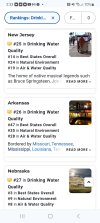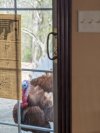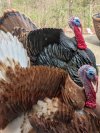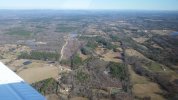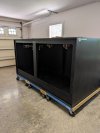Hi everyone. As I mentioned on my introductory thread, a tortoise will join our family soon. This forum has been an incredible resource, especially for theory of closed chamber design. I've made some progress on both my Aldabra enclosures (indoor & outdoor).
Indoor:
1) Found a used 'Animal Plastics' T100 (96W X 48D X 48H). Its previous inhabitant was a tegu; some lighting changes are required for tortoise. We've arranged viewing/transport by SAT. For perspective, this company has 18-34 week lead time on new cages.
2) Purchased UV meter from Etsy merchant. It compares favorably against more expensive Solarmeter brand devices.
3) Purchased another Herpstat EZ1 from Spyder Robotics. Dion was kind enough to sell me this discontinued model. If I decide against using it for Aldabra's indoor enclosure, it's a backup for my existing unit.
4) Scheduled health check for my Boxie. The veterinarian is familiar with turtles.
Outdoor:
1) Found clean (no-spray) permaculture nursery which can supply multiple species of bamboo (Pleioblastus and Sasaella), sedge grass, and prickly pear cacti.
2) Consolidated piles of brick, granite, sandstone and other materials at the site.
3) Cleaned gutters and repaired downspout to prevent flooding of site.
4) Set live traps for a young racoon that occasionally visits our patio.
Some unanswered questions:
1) What soil/substrate should I use in her outdoor enclosure? I've done some fairly large rock gardens and hardscaping, so it wouldn't be the first time I moved large volume of soil/rock.
2) What kind of outdoor hide/box is most appropriate? We're not going to leave tortoise in this enclosure overnight, but want her to be happy & humid. Medium-long term plans include a heated box from BCFab (or similar).
3) What size/shape of bowls is most appropriate? I use Pet Tekk bowls for my Boxie, and am mostly satisfied with brand quality.
4) Given the choice between city water (with chlorine) or well water (slightly hard; iron taste), what's best to use in outdoor mister/sprinkler?
I have other questions, which aren't covered by existing guides (afaik), but this seems like a good place to stop for now. Thanks again for being patient with me!
Indoor:
1) Found a used 'Animal Plastics' T100 (96W X 48D X 48H). Its previous inhabitant was a tegu; some lighting changes are required for tortoise. We've arranged viewing/transport by SAT. For perspective, this company has 18-34 week lead time on new cages.
2) Purchased UV meter from Etsy merchant. It compares favorably against more expensive Solarmeter brand devices.
3) Purchased another Herpstat EZ1 from Spyder Robotics. Dion was kind enough to sell me this discontinued model. If I decide against using it for Aldabra's indoor enclosure, it's a backup for my existing unit.
4) Scheduled health check for my Boxie. The veterinarian is familiar with turtles.
Outdoor:
1) Found clean (no-spray) permaculture nursery which can supply multiple species of bamboo (Pleioblastus and Sasaella), sedge grass, and prickly pear cacti.
2) Consolidated piles of brick, granite, sandstone and other materials at the site.
3) Cleaned gutters and repaired downspout to prevent flooding of site.
4) Set live traps for a young racoon that occasionally visits our patio.
Some unanswered questions:
1) What soil/substrate should I use in her outdoor enclosure? I've done some fairly large rock gardens and hardscaping, so it wouldn't be the first time I moved large volume of soil/rock.
2) What kind of outdoor hide/box is most appropriate? We're not going to leave tortoise in this enclosure overnight, but want her to be happy & humid. Medium-long term plans include a heated box from BCFab (or similar).
3) What size/shape of bowls is most appropriate? I use Pet Tekk bowls for my Boxie, and am mostly satisfied with brand quality.
4) Given the choice between city water (with chlorine) or well water (slightly hard; iron taste), what's best to use in outdoor mister/sprinkler?
I have other questions, which aren't covered by existing guides (afaik), but this seems like a good place to stop for now. Thanks again for being patient with me!
